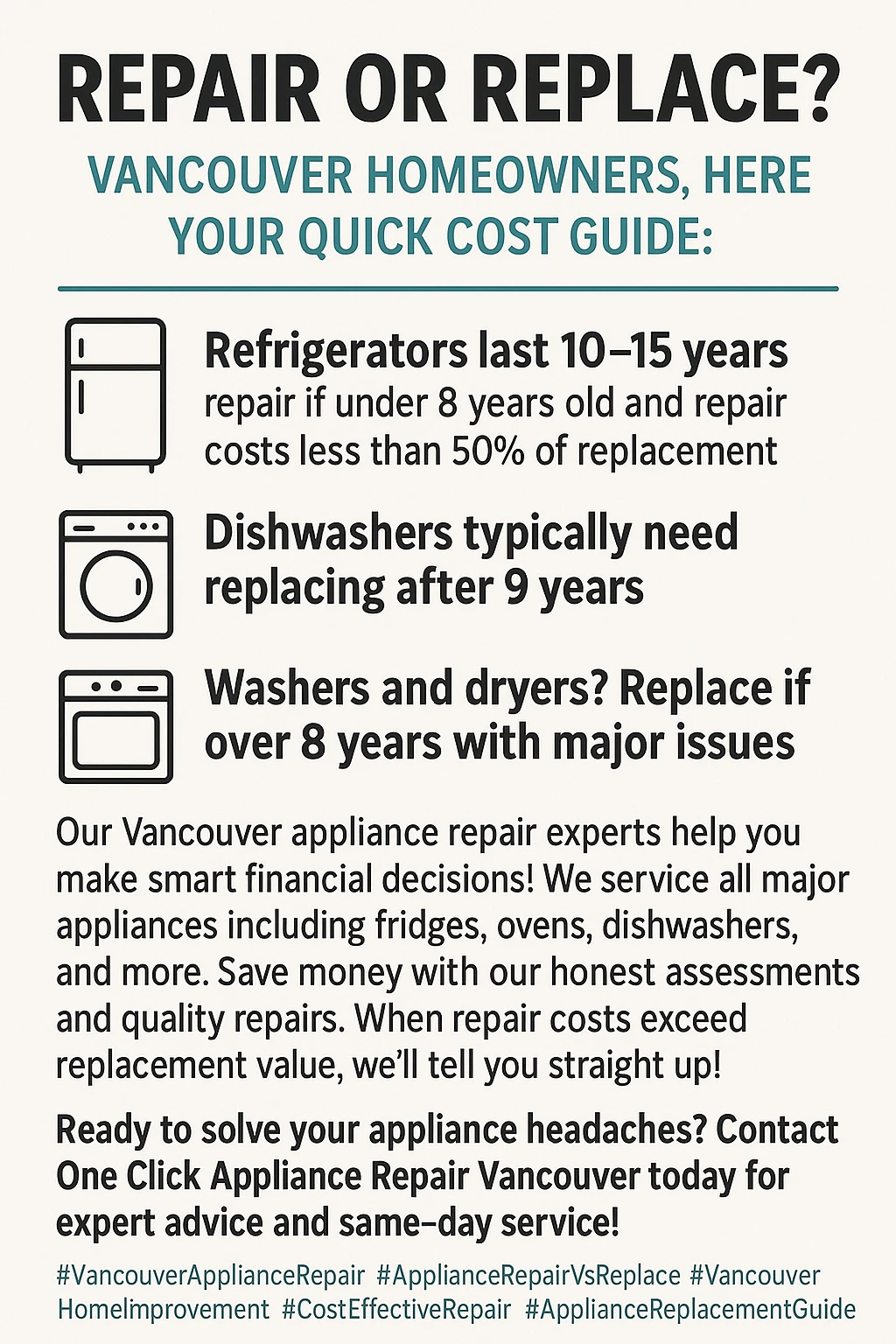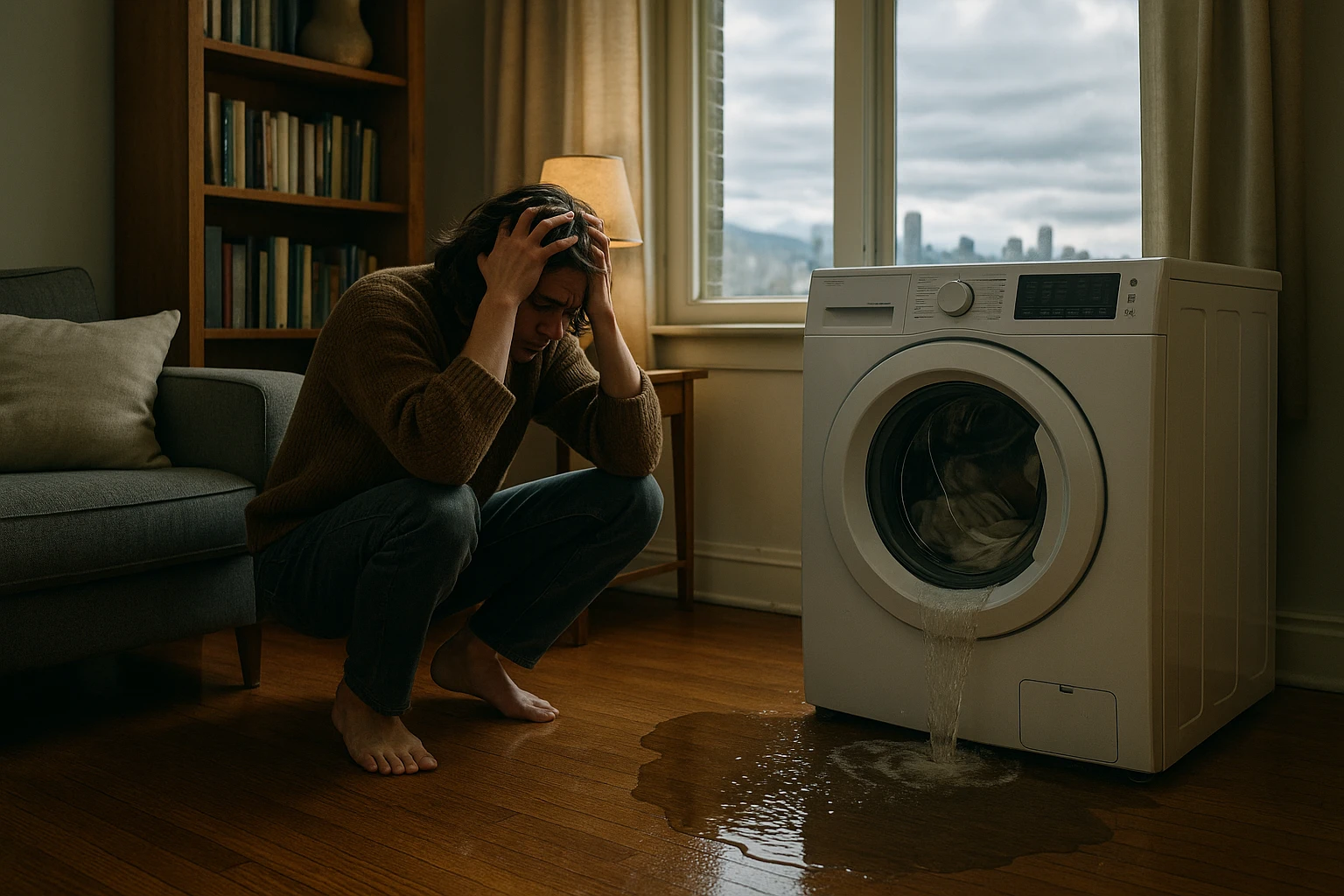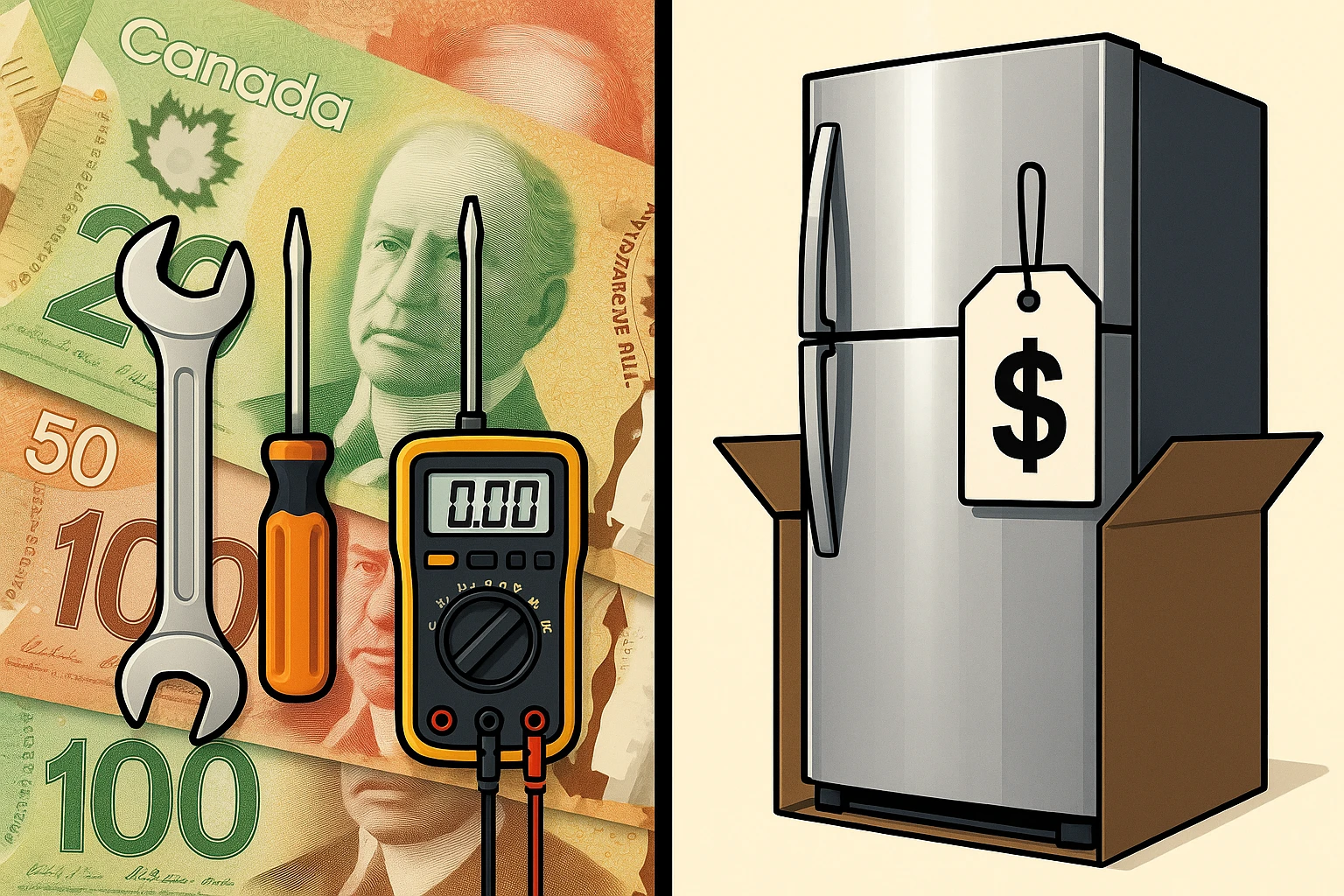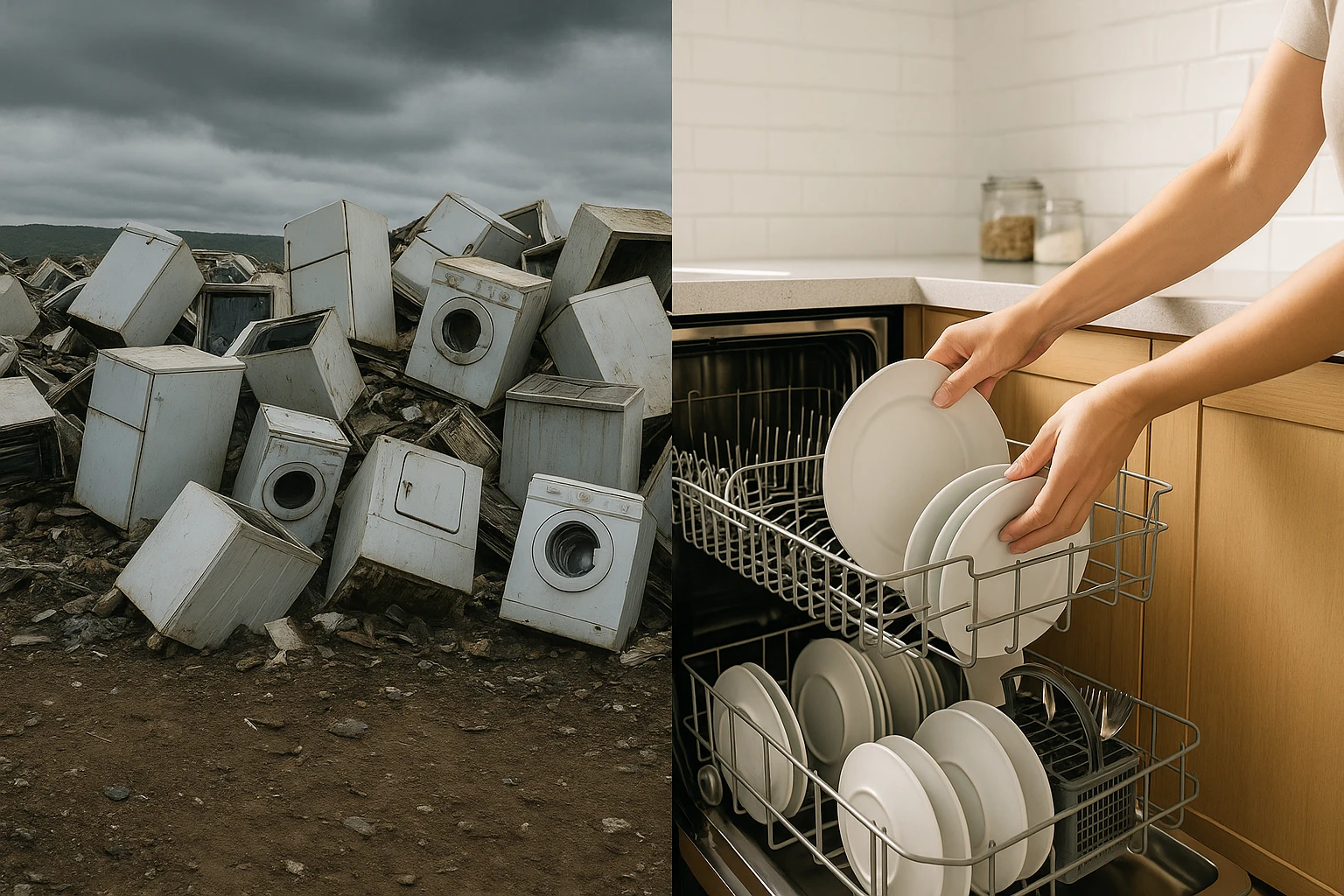Wondering whether to repair or replace your aging dishwasher that’s been making those mysterious grinding sounds? Join us as we break down the real costs, environmental impact, and practical decisions Vancouver homeowners face when their beloved appliances start acting up. Picture this: you’re hosting Sunday brunch for your friends in your cozy Kitsilano apartment when suddenly your washing machine decides to throw a tantrum. Water everywhere, strange noises that sound like a helicopter landing, and you’re standing there in your favorite slippers wondering if this is the end of an era. As a Vancouver homeowner, I’ve been there more times than I’d care to admit. Between our salty coastal air that loves to mess with our appliances and the eye-watering cost of replacements in this city, the repair versus replace dilemma hits different here than anywhere else. [IMAGE PLACEHOLDER FOR IMAGE1] Living in Vancouver means dealing with unique challenges that our appliances face daily. The humidity from our coastal location can wreak havoc on internal components, while the hard water in many neighborhoods slowly builds up scale that kills heating elements faster than you can say “False Creek.” Add in the fact that a new dishwasher can easily cost you two months of groceries, and suddenly that repair quote doesn’t look so scary. The decision isn’t just about money though. There’s something deeply satisfying about breathing new life into an old appliance, especially when you know that perfectly good machine would otherwise end up in a landfill. Plus, let’s be honest, some of those older models were built like tanks and just need a little TLC to keep chugging along for years to come.
Key Outtakes:
- Follow the 50% rule: if repair costs exceed half the price of replacement, consider buying new
- Vancouver’s coastal climate accelerates appliance wear, making regular maintenance crucial for longevity
- Appliances under 8-10 years old are usually worth repairing, especially high-end models
- Environmental impact matters: repairing keeps 5.1 million tons of appliances out of landfills annually
- Local repair services often cost $200-500, while new appliances start around $1,000 plus installation

Understanding Vancouver’s Appliance Challenge
Vancouver’s unique environment creates specific challenges that other cities rarely face when it comes to appliance longevity. Our coastal location means appliances work harder and face more stress than their counterparts in drier climates. The salt air that makes our sunsets so spectacular also accelerates corrosion on metal components inside your machines. Meanwhile, the humidity levels that keep our gardens lush can promote mold growth and moisture damage in places you’d never expect. Hard water is another silent killer that many Vancouverites don’t realize affects their appliances. Areas like Richmond and parts of Burnaby have particularly challenging water conditions that cause scale buildup in dishwashers, washing machines, and water heaters. This buildup reduces efficiency and shortens lifespan significantly. I learned this the hard way when my six-year-old dishwasher started leaving white spots on everything, and the repair technician showed me chunks of mineral buildup that looked like concrete. The cost of living in Vancouver adds another layer of complexity to the repair versus replace decision. When a basic refrigerator starts at $1,200 and a decent washing machine runs $800 or more, suddenly spending $300 on repairs doesn’t seem unreasonable. Factor in delivery fees, installation costs, and the hassle of dealing with old appliance removal, and repair becomes even more attractive.
The Financial Reality of Appliance Decisions
Understanding the true cost breakdown helps make smarter decisions about when repair makes financial sense. The famous 50% rule provides a starting point, but Vancouver homeowners need to consider additional factors that can tip the scales. This rule suggests that if repair costs exceed half the replacement value, you should probably replace the appliance. However, this guideline assumes you’re comparing apples to apples, which isn’t always the case.  When calculating replacement costs, most people forget about the hidden expenses that add up quickly. Installation fees typically range from $100 to $500 depending on the appliance complexity. A simple washer hookup might cost $150, while a built-in dishwasher installation can run $400 or more. Delivery charges add another $50 to $100, and if you need electrical or plumbing updates to accommodate a newer model, costs can spiral into the thousands. Disposal fees for old appliances often catch people off guard. While some retailers offer free haul-away with purchase, others charge $75 to $150 for this service. If you’re environmentally conscious and want proper recycling, specialized services can cost even more. These seemingly small fees add up and make repairs more attractive from a purely financial perspective. Energy efficiency deserves special consideration in Vancouver’s expensive utility market. Newer appliances often use 20-30% less energy than models from just five years ago. For a refrigerator running 24/7, this efficiency difference can save $100-200 annually on electricity bills. Over a ten-year period, these savings can offset much of the replacement cost, making new appliances more attractive for older, energy-hungry models.
When calculating replacement costs, most people forget about the hidden expenses that add up quickly. Installation fees typically range from $100 to $500 depending on the appliance complexity. A simple washer hookup might cost $150, while a built-in dishwasher installation can run $400 or more. Delivery charges add another $50 to $100, and if you need electrical or plumbing updates to accommodate a newer model, costs can spiral into the thousands. Disposal fees for old appliances often catch people off guard. While some retailers offer free haul-away with purchase, others charge $75 to $150 for this service. If you’re environmentally conscious and want proper recycling, specialized services can cost even more. These seemingly small fees add up and make repairs more attractive from a purely financial perspective. Energy efficiency deserves special consideration in Vancouver’s expensive utility market. Newer appliances often use 20-30% less energy than models from just five years ago. For a refrigerator running 24/7, this efficiency difference can save $100-200 annually on electricity bills. Over a ten-year period, these savings can offset much of the replacement cost, making new appliances more attractive for older, energy-hungry models.
Real Vancouver Repair Costs
Local appliance repair services typically charge diagnostic fees ranging from $139 to $179, usually waived if you proceed with repairs. Common repair costs in the Vancouver area break down predictably across appliance types. Refrigerator repairs usually fall between $195 and $500, with compressor issues at the high end and simple seal replacements at the low end. Washing machine repairs typically cost $195 to $350, depending on whether it’s a simple belt replacement or complex transmission work. Dishwasher repairs commonly range from $195 to $375, with pump replacements and control board issues being the most expensive fixes. Dryer repairs often cost $195 to $380, with heating element replacements being common and relatively affordable. Range and oven repairs typically fall between $195 and $300, unless you’re dealing with complex electronic controls or gas line issues. Parts availability significantly impacts repair costs and feasibility. Older appliances, particularly those over 12-15 years old, may require special ordering or refurbished components that increase both cost and repair time. Some manufacturers discontinue parts support after ten years, making repairs impossible regardless of cost considerations.
Age and Appliance Lifespan Considerations
Every appliance has an expected lifespan, and knowing where yours falls on that timeline helps inform repair decisions. Understanding these timeframes becomes particularly important in Vancouver’s challenging environment, where appliances often wear out faster than national averages suggest. The key is balancing realistic expectations with the specific conditions your appliances face. Refrigerators typically last 10 to 18 years, with higher-end models often reaching the upper end of this range. However, Vancouver’s coastal humidity can stress cooling systems, potentially shortening this lifespan by 2-3 years. If your fridge is under ten years old and needs repairs costing less than $400, it’s usually worth fixing. Between ten and fifteen years, consider the repair history and overall condition before committing to major repairs. Washing machines and dryers generally survive 10 to 13 years with proper maintenance. Front-loading washers, popular in Vancouver condos due to space constraints, often develop door seal and bearing issues around the eight-year mark. Top-loaders tend to have fewer problems but may not fit in smaller spaces. Dryers face particular challenges here due to our damp climate requiring them to work harder and longer to dry clothes effectively. Dishwashers typically last 9 to 16 years, but Vancouver’s hard water can significantly reduce this lifespan. Scale buildup damages heating elements and pumps, often requiring major repairs by year seven or eight. Regular maintenance and water softening can extend dishwasher life considerably. If your dishwasher is under seven years old, most repairs make financial sense.
When Age Trumps Everything
Once appliances cross certain age thresholds, repair becomes increasingly questionable regardless of current repair costs. A 20-year-old appliance, no matter how well-maintained, faces multiple potential failure points that can create a cascade of repair needs. Even if today’s repair costs seem reasonable, you’re likely looking at additional repairs within the next year or two. Parts availability becomes a serious concern for appliances over 15 years old. Manufacturers typically support parts availability for 10-12 years after discontinuing a model. Finding replacement components for older units often requires sourcing from specialty suppliers or salvage operations, increasing costs and repair time significantly. Consider also that older appliances lack modern safety features and efficiency standards. A 15-year-old dryer might lack thermal protection systems that prevent fires, while an old refrigerator might use refrigerants that are expensive to service and environmentally problematic. Sometimes replacing makes sense purely for safety and environmental reasons.
Environmental Impact and Sustainability
The environmental implications of repair versus replacement deserve serious consideration, especially for environmentally conscious Vancouver residents. Our city prides itself on sustainability initiatives, and appliance decisions represent a meaningful way to support these values. The manufacturing process for new appliances requires significant energy and raw materials, while disposal creates waste that persists for decades.  Every year, North Americans send approximately 5.1 million tons of appliances to landfills, while only recycling about 2.1 million tons of recoverable materials. This represents enormous waste of valuable resources including steel, aluminum, copper, and rare earth elements used in electronic controls. Vancouver’s limited landfill space makes this waste particularly problematic, as materials must often be transported long distances for disposal. Manufacturing new appliances generates substantial environmental costs that consumers rarely consider. Producing a new refrigerator requires energy equivalent to running that appliance for several months. Steel production for appliance manufacturing generates significant carbon emissions, while plastic components often contain petroleum-based materials. Transportation from manufacturing facilities to retailers adds additional environmental costs. Repairing appliances directly reduces demand for new manufacturing while extending the useful life of existing materials and energy investments. A successful repair can add 3-5 years to an appliance’s lifespan, representing significant resource conservation. Even if the repaired appliance eventually needs replacement, delaying that replacement reduces immediate environmental impact and spreads resource consumption over longer periods.
Every year, North Americans send approximately 5.1 million tons of appliances to landfills, while only recycling about 2.1 million tons of recoverable materials. This represents enormous waste of valuable resources including steel, aluminum, copper, and rare earth elements used in electronic controls. Vancouver’s limited landfill space makes this waste particularly problematic, as materials must often be transported long distances for disposal. Manufacturing new appliances generates substantial environmental costs that consumers rarely consider. Producing a new refrigerator requires energy equivalent to running that appliance for several months. Steel production for appliance manufacturing generates significant carbon emissions, while plastic components often contain petroleum-based materials. Transportation from manufacturing facilities to retailers adds additional environmental costs. Repairing appliances directly reduces demand for new manufacturing while extending the useful life of existing materials and energy investments. A successful repair can add 3-5 years to an appliance’s lifespan, representing significant resource conservation. Even if the repaired appliance eventually needs replacement, delaying that replacement reduces immediate environmental impact and spreads resource consumption over longer periods.
Balancing Efficiency and Sustainability
The sustainability calculation becomes more complex when considering energy efficiency improvements in newer appliances. A 15-year-old refrigerator might use 40% more energy than a current model, creating ongoing environmental costs through increased electricity consumption. Vancouver’s electricity comes primarily from hydroelectric sources, but transmission losses and infrastructure impacts still create environmental costs. Modern appliances often include features that reduce water consumption, particularly important given Vancouver’s water conservation initiatives. New dishwashers and washing machines use significantly less water per cycle while achieving better cleaning results. Over several years, these water savings can offset some environmental costs of manufacturing new appliances. Smart appliances offer additional efficiency benefits through optimized operation cycles and usage monitoring. These features can reduce energy consumption by 10-20% compared to conventional models, though the electronic components required for smart functionality may create additional disposal challenges when the appliance eventually fails.
Vancouver-Specific Repair Considerations
Living in Vancouver creates unique opportunities and challenges for appliance repairs that homeowners in other cities rarely face. Our city’s compact urban core means repair services can often provide same-day service, while our environmental consciousness supports a robust network of repair specialists who prioritize fixing over replacing. Understanding these local advantages helps make repair more attractive and practical. Condo living, common throughout Vancouver, creates specific constraints that favor repair over replacement. Narrow hallways, small elevators, and limited storage space make appliance replacement complicated and expensive. Moving a refrigerator through a typical Vancouver condo building often requires professional movers and can cost $200-400 beyond the appliance cost. Repairing in place eliminates these logistical nightmares. Vancouver’s repair service network has adapted to serve our unique housing stock and environmental values. Many local companies specialize in condo-friendly service calls and carry common parts for frequent repairs. This specialization means faster, more cost-effective repairs compared to cities where repair services cover larger territories and encounter more varied housing types. The city’s environmental initiatives create additional support for repair over replacement. Some BC Hydro rebate programs favor appliance tune-ups and efficiency improvements over new purchases. Municipal waste reduction programs sometimes offer incentives for repair services, recognizing that repairs reduce waste streams and disposal costs.
Climate-Specific Maintenance
Vancouver’s coastal climate demands specific maintenance approaches that can significantly extend appliance life and reduce repair needs. Understanding these requirements helps homeowners get maximum value from both repairs and existing appliances. Humidity control becomes particularly important for appliances with electronic components that can fail prematurely in moist conditions. Regular cleaning takes on added importance in our climate. Refrigerator coils exposed to humid air collect dust and debris faster, reducing efficiency and increasing energy costs. Dryer vents become particularly problematic, as our damp climate creates conditions where lint buildup can become moldy and create fire hazards. Monthly cleaning rather than seasonal maintenance becomes necessary. Hard water issues common in many Vancouver neighborhoods require proactive management to avoid premature appliance failure. Installing water softening systems or using regular descaling treatments can double the lifespan of dishwashers and washing machines. These preventive measures cost far less than frequent repairs or premature replacement.
When Replacement Makes Sense
Despite the environmental and often financial advantages of repair, certain situations clearly favor replacement over attempting fixes. Recognizing these scenarios helps avoid throwing good money after bad while ensuring you get reliable appliance performance when you need it most. Smart replacement decisions consider multiple factors beyond immediate repair costs. Safety concerns should always trigger replacement regardless of repair costs or appliance age. Gas appliances showing signs of combustion problems, electrical appliances with frequent breaker trips, or any appliance producing burning smells require immediate replacement. Vancouver’s dense housing makes appliance-related fires particularly dangerous, as they can quickly spread to neighboring units. Multiple recent repairs often indicate systemic problems that will continue generating service calls. If you’ve called for repairs three or more times in the past year, the appliance is likely approaching complete failure. Even if individual repairs seem cost-effective, the cumulative expense and inconvenience usually exceed replacement costs when you factor in lost time and potential emergency service charges. Discontinued models with poor parts availability make repairs impractical regardless of the appliance’s condition. When replacement parts require special ordering with weeks of lead time, the inconvenience often outweighs cost savings. Vancouver’s restaurant and hospitality industries have created demand for quick appliance solutions, meaning parts suppliers focus on current models rather than maintaining extensive vintage inventories.
Upgrade Opportunities
Sometimes replacement makes sense because newer appliances offer significantly improved functionality that justifies the additional cost. Modern dishwashers clean better while using less water and energy, particularly important given Vancouver’s water restrictions and high utility costs. Induction cooktops offer precise temperature control and improved safety features that can transform cooking experiences. Smart appliance features provide real value for busy Vancouver households. Remote monitoring capabilities let you check appliance status while stuck in traffic on the Lions Gate Bridge, while maintenance alerts can prevent minor issues from becoming major repairs. Energy monitoring features help optimize usage during peak rate periods, potentially saving significant money on utility bills. Space efficiency improvements in newer appliances particularly benefit Vancouver’s smaller living spaces. Counter-depth refrigerators provide full capacity while fitting better in galley kitchens common in older apartments. Compact stackable washer-dryer units can fit in closets, freeing valuable floor space for other uses.
Making the Decision
The final decision between repair and replacement requires balancing multiple factors specific to your situation and priorities. While general guidelines provide useful frameworks, individual circumstances often create exceptions that favor one choice over another. Successful decision-making involves gathering complete information and honestly assessing your needs and resources. Start by getting accurate repair estimates from reputable local services rather than relying on initial diagnostic guesses. Experienced technicians can often identify multiple issues during initial inspections, providing comprehensive repair costs that avoid surprises later. Some problems that initially appear expensive may have simple solutions, while seemingly minor issues might indicate deeper problems requiring extensive work. Consider your timeline and tolerance for inconvenience when making decisions. If you’re hosting events or running a home business, appliance reliability becomes more critical than cost optimization. Emergency replacement costs significantly more than planned purchases, but may be worthwhile to avoid disruption during important periods. Evaluate your long-term housing plans when weighing repair versus replacement decisions. If you’re planning to move within two years, expensive repairs might not provide adequate value recovery. Conversely, if you’re settled long-term, investing in quality repairs or efficient replacements makes more financial sense over extended periods.
Professional Consultation Value
Honest professional advice from experienced repair technicians provides invaluable perspective for difficult decisions. Quality repair services want to build long-term customer relationships rather than maximize individual service calls, meaning they’ll often recommend replacement when repairs don’t make sense. This professional judgment considers factors beyond immediate costs. Experienced technicians understand failure patterns for different appliance brands and models, helping predict whether current repairs will solve problems long-term or merely delay inevitable replacement. They also know which brands and models have good parts availability and reasonable repair costs over time. Get multiple opinions for expensive repair decisions, particularly when dealing with appliances approaching 10-15 years old. Different technicians may identify varying solutions with significantly different costs and reliability expectations. This additional perspective helps ensure you’re making informed decisions based on complete information rather than single viewpoints.
Frequently Asked Questions
What is the 50% rule for appliance repairs?
The 50% rule suggests that if repair costs exceed half the price of a comparable new appliance, replacement usually makes more financial sense than repair. However, this guideline requires adjustments for Vancouver’s specific conditions and costs. For example, if a washing machine repair costs $400 and a comparable new unit costs $900, the repair falls within the 50% guideline and likely makes sense. You also need to factor in additional replacement costs like delivery, installation, and disposal fees, which can add $200-500 to the total replacement expense. The rule works best for appliances in the middle of their expected lifespan. Very new appliances under warranty should almost always be repaired regardless of cost, while very old appliances approaching 15+ years may warrant replacement even for relatively inexpensive repairs. Vancouver’s high appliance costs and delivery challenges often make repairs attractive even when they slightly exceed the 50% threshold. Consider also that the 50% rule assumes you’re replacing with a similar-quality appliance. If your current unit is a high-end model, comparing repair costs to basic replacement models doesn’t provide accurate guidance. Match repair costs against comparable replacement quality levels for meaningful comparisons.
How does Vancouver’s climate affect appliance lifespan?
Vancouver’s coastal climate significantly impacts appliance longevity through several mechanisms that homeowners often overlook. The high humidity levels accelerate corrosion of metal components, particularly in appliances with frequent temperature changes like refrigerators and dryers. Salt air from our marine environment compounds this effect, causing faster deterioration of external components and ventilation systems. Hard water conditions common in Richmond, Burnaby, and other Vancouver suburbs create scale buildup that damages heating elements, pumps, and internal components. This mineral accumulation reduces efficiency and increases wear on moving parts. Dishwashers and washing machines suffer particular damage from hard water, often requiring major repairs 2-3 years earlier than in soft water areas. The combination of humidity and moderate temperatures creates ideal conditions for mold and mildew growth in appliances with poor ventilation. Washing machines, particularly front-loading models, develop seal problems and odor issues more quickly than in drier climates. Regular maintenance becomes more critical to prevent these climate-related problems from shortening appliance life.
When should I definitely replace instead of repair?
Several situations clearly indicate replacement over repair regardless of immediate costs. Safety issues should always trigger immediate replacement, including gas appliances with combustion problems, electrical units causing frequent breaker trips, or any appliance producing burning odors or unusual heat. Vancouver’s dense housing makes appliance-related hazards particularly dangerous due to proximity to neighbors. Appliances requiring multiple repairs within six months typically indicate systemic failures that will continue generating service calls. Even if individual repairs seem cost-effective, the cumulative expense and inconvenience usually exceed replacement costs. Track your repair history to identify patterns that suggest impending complete failure. Age-related replacement becomes necessary when appliances exceed 15-20 years and require major component replacement. Parts availability diminishes significantly for older units, making repairs expensive and time-consuming. Additionally, older appliances lack modern safety features and energy efficiency standards that provide both safety and cost benefits over time.
Wrapping Up
Making smart decisions about appliance repair versus replacement requires balancing multiple factors specific to Vancouver living. Our unique coastal climate, housing constraints, and high replacement costs create conditions where repair often makes more sense than in other cities. However, safety concerns, appliance age, and repair frequency can quickly tip the scales toward replacement regardless of immediate cost considerations. The 50% rule provides a useful starting point, but Vancouver homeowners need to adjust this guideline for local conditions including delivery costs, installation fees, and disposal charges that can add hundreds to replacement expenses. Factor in our challenging climate conditions that accelerate wear and the environmental benefits of extending appliance life, and repair becomes attractive for many situations that might favor replacement elsewhere. Remember that professional consultation from experienced local technicians provides invaluable perspective for difficult decisions. These experts understand Vancouver’s specific challenges and can help predict whether repairs will provide lasting solutions or merely delay inevitable replacement. When in doubt, gather multiple opinions and consider your long-term housing plans before making expensive commitments either way.


